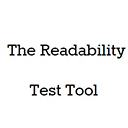Readability Test Tool

read-able.com
How readable is your writing?
Use our free readability checker and find out. Just copy and paste your writing into the box below and click the 'check my readability' button. We'll check your writing against the Flesch-Kincaid reading ease score, the Gunning Fog score and the SMOG index ('Simple Measure of Gobbledygook').
How readability checkers work
They're assessing the 'reading age' someone needs to be to understand your writing clearly on a first reading. All readability formulas work by counting the variables that have the biggest impact on readers being able to 'take in' a bit of writing: sentence length, number of syllables per words, number of passive sentences. (They don't check for spelling mistakes though.) Each formula works things out in a slightly different way. We've listed below how to interpret the various formulas – and if you want a cheat's guide, a score of about 65 is good for business writing.
But remember, the score doesn't tell you everything.
Readability formulas are excellent when you need your writing to be understood by a universal audience (say, instructions that come with medicine), and to meet 'industry benchmarks' (some US states have set a grade for all insurance documentation).
For the rest of us, they're a good rule of thumb as to whether your writing's on track. But they're a blunt instrument. It's probably already occurred to you that some long words ('hippopotamus', with five syllables) aren't 'difficult', and that a well-crafted long sentence may well be easier to read than poorly thought-through short ones.
Readability formulas can also only tell you how easy or hard your writing is to 'take in'. They can't tell you anything about whether your logic is sound or wonky, your arguments forceful or weak, your metaphors fresh or stale, or your jokes funny or flat. So, if you want an expert opinion, give us a call. We can give feedback and advice, or write, rewrite or edit just about anything.
How to interpret the different formulas
Flesch-Kincaid reading ease
The Flesch-Kincaid reading ease score is the most widely used readability checker. The US military use it to assess the readability of their technical manuals, and it's built into Word.
What it's good for: Use it to check the likelihood that your writing will be easy to read and to compare your score against other people's (like your favourite author's). Also, some countries have legislation saying you have to use Flesch-Kincaid to see if you've written something (like insurance policies) within a certain range.
How it works: It gives you two scores. A regular number, on a scale of 1 to 120 (higher is better). And a grade that shows what American school year you'd need to be at to understand it (American schools are a year behind the English system – so a seventh grade score on one of these tests means year eight in the UK).
What you should aim for: A score of around 65 is a good target for most business writing. For the grade, you're trying to hit about seven (meaning someone in seventh grade, or between 12 and 13 years old, could probably understand it).
Gunning Fog index
A reliable alternative to Flesch-Kincaid, which weighs words a tad differently.
What it's good for: It's a great second opinion. Use it if you're getting a bizarre result from the Flesch-Kincaid test. It measures in almost the same way as Flesch-Kincaid but doesn't have the problem of 100 one-word sentences getting a minus score.
How it works: Gives you an American school grade number. It's based on how many words you have with three syllables or more and how long your sentences are.
What you should aim for: Getting a lower number (grade) is ideal. Aim for about seven, which will mean even 12 to 13 year olds should be able to get what you mean. If your score's higher than 12, only university students are likely to understand you (the Harvard Law Review scores around there).
SMOG index
What it's good for: Working out the score by yourself. It gives you a pretty accurate estimate of what grade your writing is at, without the need for a computer.
How it works: If you know the maths (and understand it) you can use it to do a quick test in your head. But we'd recommend reading the test's actual website to see how (it involves square roots).
What you should aim for: The lower the better (but around seven is ideal).
